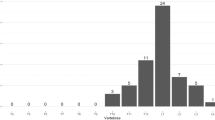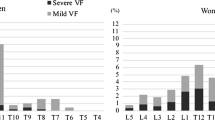Abstract
Summary
Severe vertebral fractures strongly predicted subsequent hip fracture in this population-based study. Such high-risk patients should be provided with clinical evaluation and care for osteoporosis.
Introduction
Vertebral fractures are commonly osteoporotic and known to predict hip fracture. The aim of this study was to evaluate associations between the severity of vertebral fractures and the risk of subsequent hip fracture.
Methods
Chest radiographs were obtained of 7,095 Finnish men and women aged 30 years or over in the Mini-Finland Health Survey in 1978–1980. Record linkage to the National Hospital Discharge Register identified 182 subjects from the survey who had subsequently been hospitalized for primary treatment of hip fracture by the end of 1994. A nested case–control setting was adopted, where three controls individually matched for age, gender, and place of residence were drawn for 169 subjects with hip fracture from the same cohort. Baseline vertebral fractures were identified at levels T3 to T12, and their morphology was categorized to mild, moderate, or severe according to Genant's classification.
Results
Severe vertebral fracture (>40% reduction in vertebral body height) strongly predicted hip fracture. After controlling for education, physical activity, smoking, alcohol consumption, and self-rated general health, the adjusted relative odds was 12.06 (95% confidence interval, 3.80–38.26). Mild to moderate fracture grades and the number of compressed vertebral bodies showed no prediction for hip fracture.
Conclusions
The presence of a severe vertebral fracture in the thoracic spine strongly predicts subsequent hip fracture. Such high-risk patients should be clinically evaluated and provided with care for osteoporosis and measures to reduce the risk of falling as required.
Similar content being viewed by others
References
Cummings SR, Melton LJIII (2002) Epidemiology and outcomes of osteoporotic fractures. Lancet 359:1761–1767
Cooper C, Atkinson EJ, O’Fallon WM, Melton LJIII (1992) Incidence of clinically diagnosed vertebral fractures: a population-based study in Rochester, Minnesota 1985-1989. J Bone Miner Res 7:221–227
Klotzbuecher CM, Ross PD, Landsman PB, Abbott TA, Berger M (2000) Patients with prior fractures have an increased risk of future fractures: a summary of the literature and statistical synthesis. J Bone Miner Res 15:721–739
Haentjens P, Autier P, Collins J, Velkeniers B, Vanderschueren D, Boonen S (2003) Colles fracture, spine fracture, and subsequent risk of hip fracture in men and women, a meta-analysis. J Bone Joint Surg 10:1936–1943
Hasserius R, Johnell O, Nilsson BE et al (2003) Hip fracture patients have more vertebral deformities than subjects in population-based studies. Bone 32:180–184
Schousboe JT, Howard AF, Li-Yung L, Taylor BC, Ensur KE (2006) Association between prior non-spine non-hip fractures or prevalent radiographic vertebral deformities known to be at least 10 years old and incident hip fracture. J Bone Miner Res 21:1557–1564
Cummings SR, Melton LJ (2002) Epidemiology and outcomes of osteoporotic fractures. Lancet 359:1761–1767
Aromaa A, Heliövaara M, Impivaara O et al (1989) Health, functional limitations and need for care in Finland. Basic results from the Mini-Finland Health Survey. Publications of the Social Insurance Institution AL32, Helsinki, in Finnish with English Summary
Martikainen P, Aromaa A, Heliövaara M et al (1999) Reliability of perceived health by sex and age. Sos Sci and Med 48:1117–1122
Genant HK, Wu CY, van Kuijk C, Nevitt MC (1993) Vertebral fracture assessment using a semiquantitative technique. J Bone Miner Res 8:1137–1148
Puisto V, Rissanen H, Heliövaara M, Knekt P, Helenius I (2008) Mortality in the presence of a vertebral fracture, scoliosis, or Scheuermann’s disease in the thoracic spine. Ann Epidemiology 18:595–601
Gehlbach SH, Bigelow C, Heimisdottir M, May S, Walker M, Kirkwood JR (2000) Recognition of vertebral fracture in a clinical setting. Ostoporos Int 11:577–582
Sund R, Nurmi-Lüthe I, Lüthe P, Tanninen S, Narinen A, Keskimäki I (2007) Comparing properties of audit data and routinely collected register data in case of performance assessment of hip fracture treatment in Finland. Methods Inf Med 46:558–566
Keskimäki I, Aro S (1991) Accuracy of data on diagnosis, procedures and accidents in the Finnish Hospital Discharge Register. Int J Health Sci 2:15–21
Gallacher SJ, Gallagher AP, McQuillian C, Mithchell PJ, Dixon T (2007) The prevalence of vertebral fracture amongst patients presenting with non-vertebral fractures. Osteoporos Int 18:185–192
El Maghraoui A, Mounach A, Gassim S, Ghazi M (2008) Vertebral fracture assessment in healthy men: prevalence and risk factors. Bone 43:544–548
Jiang G, Eastell R, Barrington NA, Ferrar L (2004) Comparison of methods for the visual identification of prevalent vertebral fracture in osteoporosis. Osteoporos Int Nov 15:887–896
Ferrar L, Jiang G, Armbrecht G, Reid DM et al (2007) Is short vertebral height always an osteoporotic fracture? The Osteoporosis and Ultrasound Study (OPUS). Bone 41:5–12
Ferrar L, Jiang G, Cawthon PM et al (2007) Identification of vertebral fracture and non-osteoporotic short vertebral height in men: the MrOS study. J Bone Miner Res 22:1434–1441
Cummings SR, Black DM, Nevitt MC et al (1990) Appendicular bone density and age predict hip fracture in women. The Study of Osteoporotic Fractures Research Group. JAMA 263:665–668
Kanis JA (2002) Diagnosis of osteoporosis and assessment of fracture risk. Lancet 359:1929–1936, Review
Acknowledgements
This study has been supported by the Finnish National Institute for Health and Welfare, Finnish Foundation for Paediatric Research, Finnish Orthopaedic Research foundation, Finnish Medical Foundation, Medronic International, and Baxter Finland.
Conflicts of interest
None.
Author information
Authors and Affiliations
Corresponding author
Rights and permissions
About this article
Cite this article
Puisto, V., Heliövaara, M., Impivaara, O. et al. Severity of vertebral fracture and risk of hip fracture: a nested case–control study. Osteoporos Int 22, 63–68 (2011). https://doi.org/10.1007/s00198-010-1195-4
Received:
Accepted:
Published:
Issue Date:
DOI: https://doi.org/10.1007/s00198-010-1195-4




